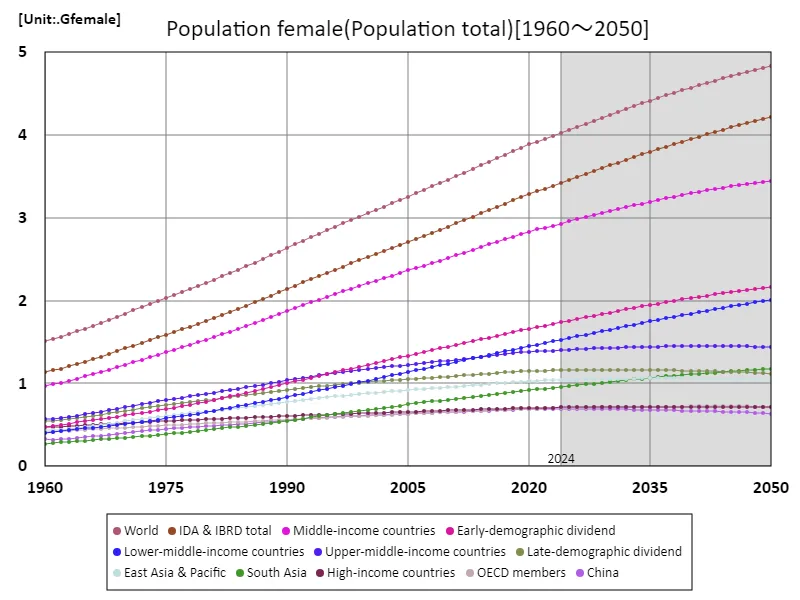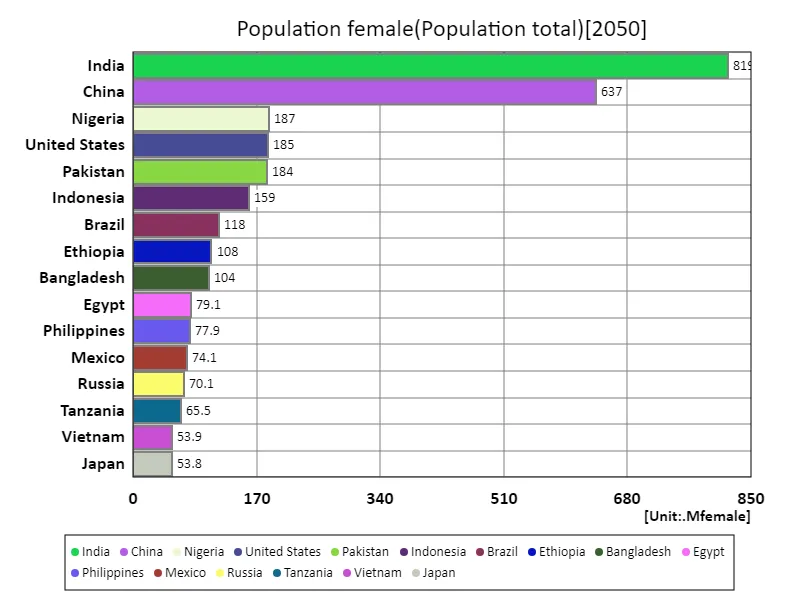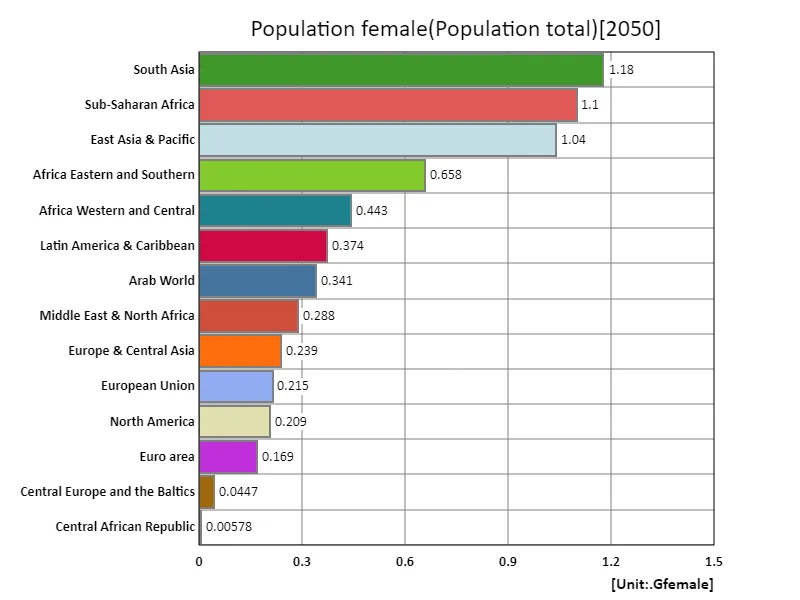Abstract
Based on data from 2024, the world’s female population is expected to reach 4.84 billion in 2050. This increase is mainly due to changes in birth rates and longer life spans. Over the past few decades, the female population has been steadily growing, with higher fertility rates, especially in developing countries, increasing the absolute number of women. Meanwhile, in developed countries, although birth rates are declining, advances in medical care are increasing life expectancy and the female population is aging. Although women’s educational attainment, labor market participation and economic role are increasing, regional disparities and gender inequality remain problems. These trends signal the need for policy decisions and societal responses, and will have an impact on future economic and social challenges.
Female population
Between 1960 and 2050, the world’s female population will show a significant increase. The female population, which was approximately 1 billion in 1960, is projected to reach 4.84 billion by 2050. This surge is due to longer lifespans due to medical advances and high birth rates in developing countries. Changes in women’s lifestyles and social status have had a major impact, especially from the late 20th century to the early 21st century. From the 1960s to the 1980s, the birth rate was high along with economic growth, and the female population also increased rapidly. Since the 1990s, birth rates have declined in many countries, and developed countries in particular have experienced a decline in birth rates and an aging population, but developing countries continue to maintain high birth rates and a growing female population. By 2050, the overall female population will peak and its share of the total population will remain stable. During this period, women were increasingly entering the workforce and their educational opportunities were expanding, and their economic and social roles were also becoming increasingly important. However, regional disparities and gender inequality remain challenges, and there is a continuing need to address these issues.


The maximum is the latest one, 4.84Gfemale of World
Female population (worldwide)
Between 1960 and 2050, India’s female population will grow significantly and is expected to reach 819 million by 2050. The rapid growth of India’s female population, which was approximately 260 million in 1960, to reach this peak is due to rapid population growth and economic development. India experienced a period of high birth rates from the 1960s to the early 2000s. This is due to the influence of an agricultural-centered social structure and traditional values that support a high birth rate. As a result, the female population increased rapidly, and with the advancement of social change due to urbanization and the spread of education, changes were also seen in women’s lifestyles. As India enters the 21st century, its economy has grown and urbanization has progressed, causing a gradual decline in its birth rate. However, the young population remains large, and the female population continues to grow. Although women’s social status is improving thanks to advances in medical care and education, regional disparities and gender inequality remain challenges. By 2050, India’s female population will reach its peak, which will have a major impact on the country’s economy and social structure. Going forward, promoting women’s education and participation in the labor market, as well as achieving gender equality, are likely to be key factors supporting the sustainability of economic growth.


The maximum is the latest one, 819Mfemale of India
Female population (worldwide, latest year)
As per the data for 2050, India’s female population will reach 819 million, while the global female population will be 4.65 billion. Looking back at historical trends, since the 1960s, India has experienced high birth rates and rapid population growth, with a significant increase in the female population. The background to this is the agricultural-centered social structure and cultural factors. In the 21st century, India has seen economic growth, urbanization, and the spread of education, but it still maintains a high birth rate. This makes India the country with the largest female population in the world. At the same time, women’s social status and labor market participation have improved, but regional disparities and gender inequality still remain. Globally, the average female population is expected to be 23.8 million in 2050, and the population is expected to continue to grow. The increase in the female population calls for policy responses in multiple areas, including education, health, and the labor market. In particular, as women’s economic role expands, a comprehensive approach to support sustainable development will be crucial.


The maximum is 819Mfemale of India, the average is 23.8Mfemale, and the total is 4.6Gfemale
Female population (region, latest year)
According to data for 2050, the world’s female population is expected to reach 6.31 billion, with South Asia accounting for the largest share, at 1.18 billion. This surge is due to demographic and economic factors specific to the region. From the 1960s to the present, South Asia has maintained high birth rates and experienced remarkable population growth. Medical advances and improved survival rates are increasing lifespans and encouraging a rise in the female population, especially in countries such as India, Pakistan and Bangladesh. On the other hand, we are also seeing a decline in birth rates due to the progress of urbanization and the spread of education. The global female population has been growing steadily since the late 20th and early 21st centuries. While economic development and social change in various regions are helping to increase women’s education levels and participation in the labor market, developing countries continue to experience high birth rates. Providing education, health and economic opportunities for a rapidly growing female population is a major challenge in South Asia. Going forward, the increase in the female population in South Asia will have a major impact on the regional economy, calling for policy responses for sustainable development. It is expected that improving women’s social status and expanding their economic role will contribute to the development of the entire region.


The maximum is 1.18Gfemale of South Asia, the average is 420Mfemale, and the total is 6.31Gfemale



Comments